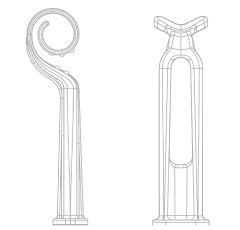Currently, I am enjoying one of the luxuries of being a school-based SLP- Spring Break! What better time for a guest post? Check out what Kristy, from Hear My Hands, has to say about incorporating sign language into speech/language therapy for the middle school population. Oh ya, don't forget to check out Kristy's website!
Currently I don’t see elementary or middle school age
students on my case load. I do work with high school students though and
therapy can get pretty tricky to maintain their attention and motivation for
even as little as the 30 minutes given to me to work with them. So … just
recently I started an agreement with a few groups that if they got done what we
needed to accomplish, then I would give them a quick mini-sign language lesson
at the end of their session. This idea went over great! The girls in different
groups thought it was ‘hot’ (their words – not mine) and so it began! But first
– we started with a figurative language lesson because how could I pass up the
opportunities to talk about ‘hot’ as in anything
but the actual temperature ‘hot’! As that moment passed and I got my
lesson accomplished, we moved onto a quick lesson in sign language! Ta-da –
success! I signed SEE YOU LATER and away they went. And let me tell you – they
remembered the next week!
Fortunately when I do work with elementary school kiddos
they are quite more compliant so I don’t have to coerce them so much. But how
would I use sign language with middle school students in therapy? There’s a few
games that could work on your goals and incorporate sign language.
1.
SignBurst!
a.
Players required: 2 +
b.
Items needed: a timer, a pile of cards
that are your target words for the session (and perhaps a couple previous
sessions), and available hands! On each card with the target word should be
additional related words (either synonyms, antonyms, associations, etc.)
c.
Rules: One student will sign the word and
the other students are required to come up with the synonym (or antonym if that
is what you are working on) for the word. So for example, the word on the card
is ‘happy’. Other words on the card are ‘glad,’ ‘excited,’ ‘cheerful,’
‘blissful,’ ‘joyful,’ etc. The one
student would sign HAPPY and the other students would have to beat the timer
with as many words as they can think of for ‘happy’. **If the students don’t
remember the sign given (e.g. HAPPY) then fingerspelling is permitted – not
speech! H-A-P-P-Y.
2.
Deaf-ine
it!
a.
Players required: 4 + (two groups of two
minimum)
b.
Items needed: target words written out on
index cards or from a worksheet
c.
Rules: With the timer started, one person
reads the definition of the word to his/her partner(s). The partner(s) is
required to sign the correct response. The team member reading the definitions
continue to read more definitions until the timer goes off. For example:
definition: “it’s round and tells times.” Other partner must sign CLOCK; and
continue to the next definition. Points will be given for each correct
response. The other team follows the same directions. At the end of each round,
the team with the most points wins that match.
3.
Sign
What? (the play on words – “Say What?”)
a.
Players required: however many other
students during that therapy session
b.
Items needed: a story or article
c.
Rules: You (the clinician) read the story
and emphasize the important parts in sign. The students need to know what the
signs are prior to the story being read. After the story is complete, you ask the
appropriate comprehension questions. The person who remembers the correct
answers gets a point. If he/she remembers the sign too, they get an additional
point.
These are just a few ideas. In my therapies, I find it’s
critical to rehearse word-finding skills. I find that almost everything I do
has some word retrieval practice in there somewhere. Using sign language (limb
gross and fine motor skills) can help jug the memory of the word(s) the student
is trying to think of. Using sign language paired with the spoken word works
different areas of the brain with the whole – here it comes big words –
visuospatial memory! A student’s sure to remember a definition to a new word or
concepts heard in a story when signs are attached to it. The use of sign language allows for a fun new
interactive way to teach the same ol’ goals.
I am able to get across my semantic language, following directions,
auditory processing/comprehension, and pragmatic goals using the three goals discussed
above. Sign language comes across as a
‘hot’ way to learn the concepts they prefer not to rehearse. Success in my book! Sign on!
Kristy works as a speech-language pathologist in
the school systems, early intervention, as well as with private clients. Her
specialty is augmentative alternative communication (AAC), which she believes
fits perfectly with ASL. Kristy uses ASL both personally (with her daughter)
and professionally in her therapy sessions and by teaching classes, tutoring
sessions, and workshops. She is a Master Level Certified Sign Language
Instructor through Signing Time®, a new blogger, a student in Nova Southeastern
University’s SLP.D program, a wife, and a new mom of a 12 month old. Please visit her new blog and her Facebook page and become
followers!
Thank you Kristy!
Talk (or rather...sign) it up!
Ashley
